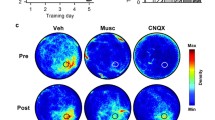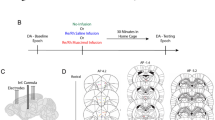Abstract
Goal-directed behaviors are thought to be supported by a neural circuit encompassing the prefrontal cortex, the dorsomedial striatum, the amygdala, and, as more recently suggested, the limbic thalamus. Since evidence indicates that the various thalamic nuclei contribute to dissociable functions, we directly compared the functional contribution of the mediodorsal thalamus (MD) and of the anterior thalamic nuclei (ATN) in a new task assessing spatial goal-directed behavior in a cross-maze. Rats sustaining lesions of the mediodorsal or the anterior thalamus were trained to associate each of the two goal arms with a distinctive food reward. Unlike control rats, both lesioned groups failed to express a bias for the goal arm corresponding to the non-devalued outcome following devaluation by sensory-specific satiety. In addition, MD rats were slower than the other groups to complete the trials. When tested for spatial working memory using a standard non-matching-to-place procedure in the same apparatus, ATN rats were severely impaired but MD rats performed as well as controls, even when spatial or temporal challenges were introduced. Finally, all groups displayed comparable breaking points in a progressive ratio test, indicating that the slower choice performance of MD rats did not result from motivational factors. Thus, a spatial task requiring the integration of instrumental and Pavlovian contingencies reveals a fundamental deficit of MD rats in adapting their choice according to goal value. By contrast, the deficit associated with anterior thalamic lesions appears to simply reflect the inability to process spatial information.




Similar content being viewed by others
References
Aggleton JP, Hunt PR, Nagle S, Neave N (1996) The effects of selective lesions within the anterior thalamic nuclei on spatial memory in the rat. Behav Brain Res 81:189–198
Aggleton JP, Poirier GL, Aggleton HS, Vann SD, Pearce JM (2009) Lesions of the fornix and anterior thalamic nuclei dissociate different aspects of hippocampal-dependent spatial learning: implications for the neural basis of scene learning. Behav Neurosci 123:504–519. doi:10.1037/a0015404
Aggleton JP, Amin E, Jenkins TA, Pearce JM, Robinson J (2011) Lesions in the anterior thalamic nuclei of rats do not disrupt acquisition of stimulus sequence learning. Q J Exp Psychol (Hove) 64:65–73. doi:10.1080/17470218.2010.495407
Babb SJ, Crystal JD (2006) Episodic-like memory in the rat. Curr Biol 16:1317–1321. doi:10.1016/j.cub.2006.05.025
Balleine BW, Dickinson A (1998) Goal-directed instrumental action: contingency and incentive learning and their cortical substrates. Neuropharmacology 37:407–419
Balleine BW, O’Doherty JP (2010) Human and rodent homologies in action control: corticostriatal determinants of goal-directed and habitual action. Neuropsychopharmacology 35:48–69. doi:10.1038/npp.2009.131
Balleine B, Ball J, Dickinson A (1994) Benzodiazepine-induced outcome revaluation and the motivational control of instrumental action in rats. Behav Neurosci 108:573–589
Balleine BW, Killcross AS, Dickinson A (2003) The effect of lesions of the basolateral amygdala on instrumental conditioning. J Neurosci 23:666–675
Corbit LH, Balleine BW (2003) The role of prelimbic cortex in instrumental conditioning. Behav Brain Res 146:145–157
Corbit LH, Janak PH (2010) Posterior dorsomedial striatum is critical for both selective instrumental and Pavlovian reward learning. Eur J Neurosci 31:1312–1321. doi:10.1111/j.1460-9568.2010.07153.x
Corbit LH, Muir JL, Balleine BW (2003) Lesions of mediodorsal thalamus and anterior thalamic nuclei produce dissociable effects on instrumental conditioning in rats. Eur J Neurosci 18:1286–1294
Coutureau E, Marchand AR, Di Scala G (2009) Goal-directed responding is sensitive to lesions to the prelimbic cortex or basolateral nucleus of the amygdala but not to their disconnection. Behav Neurosci 123:443–448. doi:10.1037/a0014818
Dickinson A (1985) Actions and habits: the development of behavioural autonomy. Phil Trans R Soc Lond B 308:67–78
Dupire A, Kant P, Mons N, Marchand AR, Coutureau E, Dalrymple-Alford J, Wolff M (2013) A role for anterior thalamic nuclei in affective cognition: interaction with environmental conditions Hippocampus 23:392–404. doi:10.1002/hipo.22098
Gabbott PL, Warner TA, Jays PR, Salway P, Busby SJ (2005) Prefrontal cortex in the rat: projections to subcortical autonomic, motor, and limbic centers. J Comp Neurol 492:145–177. doi:10.1002/cne.20738
Groenewegen HJ (1988) Organization of the afferent connections of the mediodorsal thalamic nucleus in the rat, related to the mediodorsal-prefrontal topography. Neuroscience 24:379–431
Hayen A, Meese-Tamuri S, Gates A, Ito R (2014) Opposing roles of prelimbic and infralimbic dopamine in conditioned cue and place preference. Psychopharmacology. doi:10.1007/s00213-013-3414-0
Holmes NM, Marchand AR, Coutureau E (2010) Pavlovian to instrumental transfer: a neurobehavioural perspective. Neurosci Biobehav Rev 34:1277–1295. doi:10.1016/j.neubiorev.2010.03.007
Hoover WB, Vertes RP (2007) Anatomical analysis of afferent projections to the medial prefrontal cortex in the rat. Brain Struct Funct 212:149–179. doi:10.1007/s00429-007-0150-4
Hunt PR, Aggleton JP (1998a) An examination of the spatial working memory deficit following neurotoxic medial dorsal thalamic lesions in rats. Behav Brain Res 97:129–141
Hunt PR, Aggleton JP (1998b) Neurotoxic lesions of the dorsomedial thalamus impair the acquisition but not the performance of delayed matching to place by rats: a deficit in shifting response rules. J Neurosci 18:10045–10052
Hunt PR, Neave N, Shaw C, Aggleton JP (1994) The effects of lesions to the fornix and dorsomedial thalamus on concurrent discrimination learning by rats. Behav Brain Res 62:195–205
Jankowski MM et al (2013) The anterior thalamus provides a subcortical circuit supporting memory and spatial navigation. Front Syst Neurosci 7:45. doi:10.3389/fnsys.2013.00045
Killcross S, Coutureau E (2003) Coordination of actions and habits in the medial prefrontal cortex of rats. Cereb Cortex 13:400–408
Loukavenko EA, Ottley MC, Moran JP, Wolff M, Dalrymple-Alford JC (2007) Towards therapy to relieve memory impairment after anterior thalamic lesions: improved spatial working memory after immediate and delayed postoperative enrichment. Eur J Neurosci 26:3267–3276. doi:10.1111/j.1460-9568.2007.05879.x
Marchand A, Faugere A, Coutureau E, Wolff M (2013) A role for anterior thalamic nuclei in contextual fear memory. Brain Struct Funct 219 (5):1575–1586. doi:10.1007/s00429-013-0586-7
McDannald MA, Jones JL, Takahashi YK, Schoenbaum G (2014) Learning theory: a driving force in understanding orbitofrontal function. Neurobiol Learn Mem 108:22–27. doi:10.1016/j.nlm.2013.06.003
Mitchell AS, Browning PG, Baxter MG (2007) Neurotoxic lesions of the medial mediodorsal nucleus of the thalamus disrupt reinforcer devaluation effects in rhesus monkeys. J Neurosci 27:11289–11295. doi:10.1523/JNEUROSCI.1914-07.2007
Ostlund SB, Balleine BW (2005) Lesions of medial prefrontal cortex disrupt the acquisition but not the expression of goal-directed learning. J Neurosci 25:7763–7770. doi:10.1523/JNEUROSCI.1921-05.2005
Ostlund SB, Balleine BW (2008) Differential involvement of the basolateral amygdala and mediodorsal thalamus in instrumental action selection. J Neurosci 28:4398–4405. doi:10.1523/JNEUROSCI.5472-07.2008
Parkes SL, Balleine BW (2013) Incentive memory: evidence the basolateral amygdala encodes and the insular cortex retrieves outcome values to guide choice between goal-directed actions. J Neurosci 33:8753–8763. doi:10.1523/JNEUROSCI.5071-12.2013
Pickens CL (2008) A limited role for mediodorsal thalamus in devaluation tasks. Behav Neurosci 122:659–676. doi:10.1037/0735-7044.122.3.659
Smith KS, Virkud A, Deisseroth K, Graybiel AM (2012) Reversible online control of habitual behavior by optogenetic perturbation of medial prefrontal cortex. Proc Natl Acad Sci USA 109:18932–18937. doi:10.1073/pnas.1216264109
Tanaka SC, Balleine BW, O’Doherty JP (2008) Calculating consequences: brain systems that encode the causal effects of actions. J Neurosci 28:6750–6755. doi:10.1523/JNEUROSCI.1808-08.2008
Tran-Tu-Yen DA, Marchand AR, Pape JR, Di Scala G, Coutureau E (2009) Transient role of the rat prelimbic cortex in goal-directed behaviour. Eur J Neurosci 30:464–471. doi:10.1111/j.1460-9568.2009.06834.x
Ulrich K, Aitken PN, Abraham WC, Dalrymple-Alford JC, McNaughton N (2014) Effects of thalamic lesions on repeated relearning of a spatial working memory task. Behav Brain Res 261:56–59. doi:10.1016/j.bbr.2013.12.002
Valentin VV, Dickinson A, O’Doherty JP (2007) Determining the neural substrates of goal-directed learning in the human brain. J Neurosci 27:4019–4026. doi:10.1523/JNEUROSCI.0564-07.2007
van Groen T, Kadish I, Michael Wyss J (2002) Role of the anterodorsal and anteroventral nuclei of the thalamus in spatial memory in the rat. Behav Brain Res 132:19–28
Warburton EC, Baird AL, Aggleton JP (1997) Assessing the magnitude of the allocentric spatial deficit associated with complete loss of the anterior thalamic nuclei in rats. Behav Brain Res 87:223–232
Warburton EC, Morgan A, Baird AL, Muir JL, Aggleton JP (1999) Does pretraining spare the spatial deficit associated with anterior thalamic damage in rats? Behav Neurosci 113:956–967
Warburton EC, Baird AL, Morgan A, Muir JL, Aggleton JP (2000) Disconnecting hippocampal projections to the anterior thalamus produces deficits on tests of spatial memory in rats. Eur J Neurosci 12:1714–1726
Warburton EC, Baird A, Morgan A, Muir JL, Aggleton JP (2001) The conjoint importance of the hippocampus and anterior thalamic nuclei for allocentric spatial learning: evidence from a disconnection study in the rat. J Neurosci 21:7323–7330
Ward-Robinson J, Wilton LA, Muir JL, Honey RC, Vann SD, Aggleton JP (2002) Sensory preconditioning in rats with lesions of the anterior thalamic nuclei: evidence for intact nonspatial ‘relational’ processing. Behav Brain Res 133:125–133
Wilton LA, Baird AL, Muir JL, Honey RC, Aggleton JP (2001) Loss of the thalamic nuclei for “head direction” impairs performance on spatial memory tasks in rats. Behav Neurosci 115:861–869
Wolff M, Gibb SJ, Dalrymple-Alford JC (2006) Beyond spatial memory: the anterior thalamus and memory for the temporal order of a sequence of odor cues. J Neurosci 26:2907–2913
Wolff M, Gibb SJ, Cassel JC, Dalrymple-Alford JC (2008a) Anterior but not intralaminar thalamic nuclei support allocentric spatial memory. Neurobiol Learn Mem 90:71–80. doi:10.1016/j.nlm.2008.01.007
Wolff M, Loukavenko EA, Will BE, Dalrymple-Alford JC (2008b) The extended hippocampal-diencephalic memory system: enriched housing promotes recovery of the flexible use of spatial representations after anterior thalamic lesions. Hippocampus 18:996–1007. doi:10.1002/hipo.20457
Yin HH, Ostlund SB, Knowlton BJ, Balleine BW (2005) The role of the dorsomedial striatum in instrumental conditioning. Eur J Neurosci 22:513–523. doi:10.1111/j.1460-9568.2005.04218.x
Acknowledgments
This work was supported by the CNRS and the Conseil Régional d’Aquitaine. F. A. is supported by the Ministère de l’Enseignement Supérieur. We thank D. Panzeri, N. Argenta, and J. Huard for their help in animal care.
Author information
Authors and Affiliations
Corresponding authors
Additional information
F. Alcaraz and F. Naneix contributed equally.
M. Wolff and E. Coutureau contributed equally as senior authors.
Rights and permissions
About this article
Cite this article
Alcaraz, F., Naneix, F., Desfosses, E. et al. Dissociable effects of anterior and mediodorsal thalamic lesions on spatial goal-directed behavior. Brain Struct Funct 221, 79–89 (2016). https://doi.org/10.1007/s00429-014-0893-7
Received:
Accepted:
Published:
Issue Date:
DOI: https://doi.org/10.1007/s00429-014-0893-7




